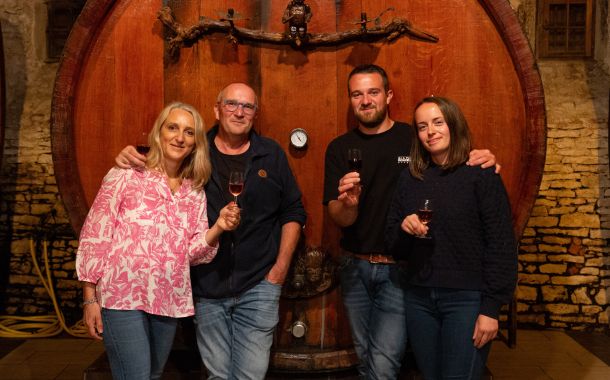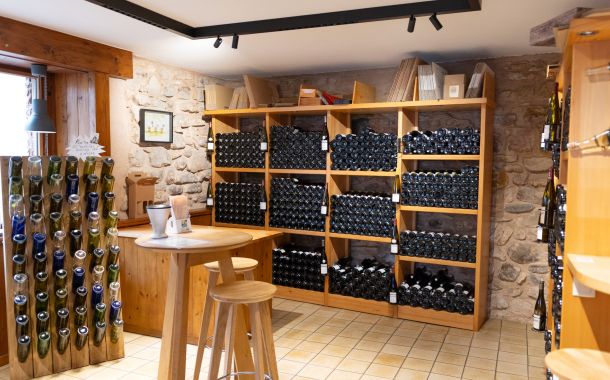Welcome to Domaine Gilg
in Mittelbergheim

Our production is divided between the 7 traditional Alsatian grape varieties, as well as Klevener de Heiligenstein (Savagnin Rose) and Chardonnay (used only for the production of Crémant d’Alsace).
5 hectares are located in Grand Cru Zotzenberg in Mittelbergheim and 1 hectare in Grand Cru Moenchberg in Andlau and Eichhoffen.
After a long transition period during which our estate was certified as High Environmental Value, we are now certified as Organic Agriculture since the 2021 harvest.
Our estate has several cellars, all connected through basement, covering more than 1200 m2. Two of these cellars are from 1572 and 1585, the others have been carved between 1964 and 1993.
We sell all of our harvest in bottles, mainly to an European clientele.
Our family estate is located in the middle village of Mittelbergheim, on the Alsatian Wine Road. The village is classified among the most beautiful villages in France.
We are a family of independent winemakers. As such, we work our vines, harvest our grapes, vinify our wines and market them: a guarantee of authenticity!
The Domaine Armand Gilg currently cultivates 30 hectares of vines on the Vosges’s hills at an altitude of 160 m to 310 m.
The Alsatian vineyard is very fragmented. As a result, our estate has about a hundred plots, varying in size from 6 to 140 ares. Our vines are located within a radius of 3 kilometres around Mittelbergheim, and the neighbouring municipalities: Andlau, Eichhoffen, Barr, Gertwiller.


Our family history
Our family, native from Austria, settled in Mittelbergheim in 1601. Our name comes from the word “Lilie”, which means “Lily flower” in German.
Since then, 16 generations have followed, of which the 12 or 13 first generations certainly lived just as the rest of the village : through polyculture, winemaking and probably also from cooperage.
The contemporary winemaking history of the familly really began in 1937 when Armand and Eugenie Gilg moved in across from the family home to develop their farming and winemaking business.
In 1947, the estate had 1.2 hectares of vines and a 100 m2 cellar in a Renaissance house dating from 1572.
In 1963, Armand and Eugénie acquired the neighbouring house dating from 1585 and the adjoining barns, which allowed the creation of a bottle cellar and a shop.
In 1971, their three children : Armand, Christiane and Jean-Pierre took over. The estate counts then 10 hectares of vines, and new bottle cellars and a pressing building are built.
Today, the winery still carries the name of Armand Gilg (senior), and its owner is Jean-Christophe Lehner: son of Christiane Lehner-Gilg. He’s currently working with his wife Michèle and his son Etienne.



Our environmental approach


Our winery has always chosen sustainable management for our plots.
Since the 2021 harvest, we have been certified in Organic Agriculture.
For more than 40 years, we have been exercising the technique of controlled grassing over 1 row out of 2, the other row being ploughed or scratched.
In 2009, before our conversion to organic, the estate was equipped with a tool for working the soil under the row, for ridging, earthing up, weeding and mowing at the foot of the vines, avoiding completely the use of herbicides.
Mowing in the grassed rows is avoided as much as possible: we use Rolofacas, tools that allow the plants to lie on the ground and pinch them to stop the rise of the sap on the grassed rows. This natural mulch limits erosion and water evaporation, keeps the soil cool, promotes soil biomass and limits compaction.
Working the soil allows us to weed naturally, and avoid too much competition with the vines, but also to decompact the soil, regulate humidity, and encourage deep root penetration.
We limit the use of fertilisers and of course only use organic fertilisers on the plots that require it.


To control grape berry worms without using insecticides, we use sexual confusion by installing pheromone-diffusing filaments. These pheromones prevents the males from locating the females. The capsules are placed in April.
Everything we do contributes to maintaining a natural balance, biodiversity and preserving the quality of the soil, our main asset.